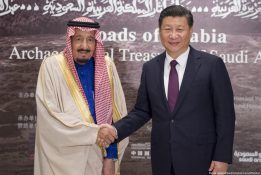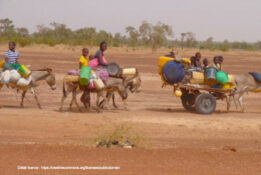Cet article présente et reprend une analyse de l’année 2017, année clef pour les nations de l’Asie du Sud-Est formant l’ASEAN. Alors que cette communauté ASEAN vient de fêter ses 50 ans d’existence, l’auteur montre comment la montée en puissance de la Chine conjuguée aux incertitudes de la politique de l’administration Trump crée une situation inédite, dont la gestion suppose de savoir prendre en compte les sensibilités politico-culturelles locales.
Les opinions exprimées dans cet article n’engagent pas le CSFRS.
Les références originales de ce texte sont: , Brij Khindaria, « ASEAN: Uneasy tigers trapped between China and the US », Les Cahiers du Comité Asie de l’ANAJ-IHEDN, Eté 2017.
Ce texte, ainsi que d’autres publications, peuvent être visionnés sur le site de l’ANAJ-IHEDN.
ASEAN: Uneasy tigers trapped between China and the US
Headnote : January 2018
After 50 years of cultivating harmony, divisions persist among Southeast Asian Nations (ASEAN). The sobering uncertainties of President Donald Trump’s impacts on their neighborhood and China’s ominous inscrutability are adding to their jitters.
The region enters 2018 against a backdrop of apprehension that Trump may start new tensions with China. He may try to use trade restrictions to coerce President Xi Jinping to take a much tougher line against North Korea’s impetuous Kim Jong-un, who is determined to acquire nuclear weapons capable of striking the US homeland. ASEAN members are sandwiched in the growing rivalry between Washington and Beijing. Both are overwhelmingly powerful economic and diplomatic partners vital for their prosperity and between which taking sides would be perilous.
At the Asia-Pacific Economic Co-operation (APEC) summit in November 2017, Trump took a firm line against Xi going beyond his frustration over North Korea. He perceives China as seeking to unseat the US as the most powerful influence in South East Asia and laid out some counter strategies that Beijing sees as being troublesome. Without directly naming any country, he also insisted that the US would no longer tolerate « chronic trade abuses », which is his pet peeve against Beijing.
Introduction
ASEAN’s great achievement is peaceful cooperation among its members in a region wracked by wars through the centuries. It has weathered the 20th century wars of France and America in Vietnam, Communist Dictator Pol Pot’s genocide of 25 percent of his own people in Cambodia, and harsh military rule in Myanmar.
Improbably, its members – Thailand, Indonesia, Vietnam, Singapore, Philippines, Malaysia, Myanmar, Cambodia, Laos and Brunei – turned into economic tigers and the region still has one of the highest potentials in Asia. This article looks at some of ASEAN’s economic prospects and its significance to the region from Myanmar to Japan.
The grouping will celebrate its 50th anniversary on August 8, 2017, but falls short of its motto, “One Vision, One Identity, One Community”. Overall, it communicates lack of clarity. It is not a political union, nor a common market, nor an integrated internal market. None of its members is a liberal democracy in the Western sense and tiny Singapore might be the only member with an almost untarnished human rights record.
Although ASEAN never had pretensions of moving in these directions, it does not seem to know what it wants to be or what the term “One” might mean for its members beyond a catchphrase. Although members meet very often in various committees, its secretariat is a small operation with a US$17 million budget. Its identity is loosely knit and, in Henry Kissinger’s famous phrase, there is nobody to call for a decision.
As the current ASEAN chair, Philippines President Rodrigo Duterte will preside at the celebrations in Manilla. The celebratory theme “Partnering for Change, Engaging the World” voices aspirations for unity within ASEAN and with global partners. The vague slogan “An even stronger ASEAN begins today,” is the anniversary’s hope for building upon the first half century.
It is true that since 1967, ASEAN has matured into a community focused on economic integration and growth, and consensus-building. Results have included unprecedented economic growth turning ASEAN into the world’s third-largest labor force and seventh-largest market, forecast to become the fourthlargest economic bloc by 2030.
But the jury is still out on whether the economic successes grew out of foreign investments seeking to profit from lower costs or better economic integration within ASEAN. The question remains whether each member became successful because of its own devices or partnership within the Association served as a trampoline for success.
ASEAN has never tried to be an integrated market like the European Union, where some aspects of national sovereignty are pooled with other members for the economic gain of all members. However, the efficacy of its loose style of collaboration remains to be seen in the emerging cut-throat future of speedier globalization of supply chains and markets.
Doubts remain whether ASEAN can rise to its potential without following the EU pattern of building an internal market and standing together to strike tougher bargains in negotiations. Unity may be still more important if Trump implements his promises to make profound changes to trade, especially if he serves two terms as President.
Leading world economies are already buffeted by upheavals provoked by big data and the socalled fourth industrial revolution, including artificial intelligence and robotization that reduce lessskilled jobs. Such disruptions will further sharpen the edges of globalization, which is already dominated by ever-more integration of financial flows, supply chains, logistics, banking, online commerce and trade.
In this context, ASEAN is lagging behind despite its achievements so far. After years of political hesitation, its members recently set up the ASEAN Economic Community to create a single market and production base to facilitate “even closer economic, political, social, and cultural cooperation”. But the challenges are many since there are serious deficits of trust and political will among member states.
ASEAN: The Singapore model
The tiger economies are still buzzing but seem short on ideas to realize their potential. The diversity of political and social systems among members has kept most from building solidly upon the Western, Japanese, Chinese and Korean investments that helped them to race ahead in earlier decades. That momentum has slowed although Singapore continues at the leading-edge of innovations.
Singapore is the main success story and deserves special consideration for its leadership as a role model for ASEAN and China. It is a standalone case because its policy-makers showed extraordinary foresight in giving pride of place to education, non-discrimination among ethnic groups, open markets and financial discipline. Those positive characteristics are absent to various degrees in other ASEAN members.
Tiny Singapore is similar in size to the Philippines Subic Bay naval base and free port zone but has become a catalyzing hub for the entire region from India to Japan. It has entered supply chains and set an example of how financial investments can be more important than trade for advancing globalization. Because of current paths of financial flows, even sharp trade protectionism or tough controls on skilled professionals cannot halt globalization because companies would simply increase foreign direct investments (FDI) to be nearer their markets.
In fact, estimates put FDI at 60 percent of global GDP currently, up from 30 percent in 1980. From almost nothing at its founding as a Republic in 1965, Singapore has built itself into a hub catalyzing FDI and finance for ASEAN and the wider region. Forbes magazine ranks it as the world’s third richest country with a per capita GDP of nearly US$53,000.
Because of its innovative policies, Singapore has been a role model for China for 40 years. Chinese leaders from Deng Xiaoping to Xi Jinping have regularly visited Singapore and taken advice on setting up and managing special economic zones and industrial parks. Ten such zones are China’s most important flagships for high technology.
Singapore also provided the model for China’s upward climb in the value chain. Just 20 years ago, China was the low-cost producer of T-shirts and shoes. Now it produces the most computers in the world but imports only 30 percent of electronic components, down from 60 percent a decade earlier. It is an important trade facilitator for 124 countries. The US is a top partner for only 52 countries and may erode even that position if Trump puts his protectionist policies in place. Further erosion is likely from China, which is massively increasing its connectivity to the world through infrastructure investments at home and in its trading partners.
ASEAN economies became integrated mainly because of their role in global supply chains of the 20th century’s final quarter, starting with Japanese auto companies in the 1980s and electronics and textiles later. Although members have eliminated nearly 95 percent of tariffs in intra-ASEAN trade, their internal trade is still only 30 percent while trade with Asia is 53 percent. Because of economic disparities within ASEAN, Singapore, Malaysia and Vietnam individually entered Obama’s trade flagship, the Trans Pacific Partnership (TPP).
Trump has withdrawn America from TPP but Japan and others are trying to revive it without the US. The 11 remaining countries will meet in Hanoi in May to decide on next steps.
ASEAN: resolving challenges
This year’s half-century mark may not see history-making changes but it will herald forward movement. That could help ASEAN members to better fructify the potential attributed to them by many analysts as the next economic giant surpassing India but not China.
The hope lies in the ASEAN Economic Community (AEC), which is a blueprint established in 2015 for advancing towards 2025. Its ambition is of a more unified market for the movement of goods, services, investment, capital and skilled labor — but it has a long way to go.
The chief obstacles to its ambitions are internal politics but some derive from ASEAN being caught between a rock and a hard place. The rock is China, which is ever more aggressive in its economic, trade and military policies as it tries to push aside American regional hegemony. The hard place is Trump’s determination to contain China through expanded defense and naval presence in the region all the way from the South China Sea to the Sea of Japan.
Gradually ASEAN members, including Thailand, Malaysia, Vietnam and Philippines, are adopting parts of the Singapore model. They are fast becoming the world’s factory replacing China because they are improving integration into global supply chains while working better with one another. For example, Vietnamese companies are outsourcing to Laos and Cambodia, while Myanmar is borrowing from Singapore banks. The 10 nations already generate a higher GDP than India with half the population. They also have low labor costs and young populations.
Most ASEAN countries are still wary of one another, although Singapore and Malaysia, which are former foes, will soon be connected by high-speed rail between their capitals. The political trust needed to realize the entire group’s potential is missing partly because of unstable governments, domestic corruption and terrorism in some pockets, as in Myanmar, Thailand, Philippines and Indonesia.
There are fundamental differences between the Singapore model and the Western model of democracy, including the social contract among the people and government. These gaps may widen if Trump moves away, as he has said, from the nearly 50-year-old Western model that emphasizes freedom of expression, human rights and liberal democracy.
The social contract in ASEAN between the people and government seems more stable but less free than in the West, at least for the moment. The governments in China and Singapore offer a hierarchical model where prosperity and security for citizens are traded-off for fewer democratic freedoms to protest or obstruct government decisions. Governments tend to be utilitarian and technocratic and may accept what might appear as human rights violations to Western liberals. Vietnam is leaning in this direction as are some others, including Thailand, Cambodia and Laos.
The Western model is not winning converts partly because the largest Asian democracies — India, Philippines and Indonesia — have not managed to create welfare and stability. They are perceived as chaotic countries that practice democracy in the sense of one-person one-vote but do not offer the legal, social welfare and human rights protections common in Western democracies. So, Southeast Asians may be leaning towards a technocratic model of democracy similar to Singapore. But these are early days and drawing longer-term conclusions would be imprudent.
Still, ASEAN could nourish alternative models of governance and social organization to those promoted so far by US-led Western powers. That would further erode Western influence in Asia, which is seen as a continent of vast opportunity by most large businesses. Some analysts say the “American dream” is now the “Asian dream”. Bankers point out that more people live in Asia than anywhere else. Nowhere else have assets increased more rapidly over the past 10 years. Nowhere else are there more high net worth individuals.
In 1984, China accounted for less than two percent of the global economy. Now, it is the second largest after the US with a US$11 trillion GDP. In ASEAN, GDP has more than tripled since 2001 to US$2.6 trillion in 2016 (India was US$2.3 trillion).
Despite the possibilities, it is uncertain whether ASEAN will rise to its potential. Politics are likely to force issues of regional integration into the background because some members will hold contentious elections soon. Even Singapore’s presidential elections due by August 2017 may be prickly because for the first time the post is open to only ethnic Malay candidates, although it still is non-partisan and mostly ceremonial.
Thailand, which has long struggled between its generals and civilians, could return to some form of controlled democracy after elections in late 2017. Malaysia may hold a snap election this year because prime minister Najib Razak is under fire from investigators scrutinizing a government investment fund. They have allegedly traced very large deposits into what they believe are his personal bank accounts. He is strenuously denying wrong-doing.
Local-level elections are also due in Cambodia later this year, while April elections in Djakarta, Indonesia, have caused much controversy. They brought victory to Anies Baswedan, the first Chinese-Christian to govern the capital city of that Muslim majority nation.
In Myanmar, the honeymoon period of Nobel Laureate Aung San Suu Kyi’s administration is nearing an end and her government faces continued international criticism about Buddhist-inspired violence against the Muslim Rohingya minority.
The regional context
The controversial « war on drugs” of Philippines President Duterte is already cooling the West’s relations with his country. About 6,000 suspects are reported killed by vigilantes and police with impunity because of support from Duterte.
But on April 29, 2017, Trump said he had “a very friendly” telephone conversation with Duterte and extended an invitation to visit the White House. This outraged some human rights bodies already angered by Duterte’s apparent rejection of the rule of law as they conceive it.
With typical bravado, Duterte responded on May 1 to Trump saying, “I am tied up. I cannot make any definite promise.” Trump is trying to mend America’s fences with Duterte as part of his containment policy towards China. He also seems to like Duterte as a feisty person who used abusive language against former President Barack Obama late last year.
Obama criticized the killings in Duterte’s war on drugs causing him to threaten separation from close military and other links with the US, cultivated over decades. He threatened to lean towards China and weaken long-standing defense pacts with the US military causing concern at the Pentagon. Trump wants to increase American naval presence in the South China Sea to counter Chinese military expansion on islands in the region, which would require considerable tightening of military links with the Philippines.
ASEAN is simply a mercantilist group that cooperates to increase prosperity but is not committed to a shared vision of cultural identity or how people should be governed. In contrast, most EU members already are or aspire to be liberal democracies subject to rule of law and their people are loosely rooted in Christian cultural identity.
ASEAN’s largest power Indonesia is home to 250 million people, almost all Muslim (87 percent) and Malaysia has a Muslim majority of 62 percent. This diversity means that ASEAN governments do not lean naturally towards cooperation to protect and promote a common vision of cultural identity or system of governance. Nor do they lean towards creating a military alliance for collective security patterned on NATO. Their rule of consensus also means that all decisions are slow and laborious.
Additionally, there is a divide between inwardlooking countries like Thailand, Cambodia, Laos and Myanmar and more outward-looking maritime nations like Indonesia, Philippines, Malaysia and Vietnam. Most EU languages have a common root but indigenous languages in ASEAN are more diverse. So, instilling enough cohesion within ASEAN to turn it into a unified spearhead of economic or other diplomacy siding with the West is difficult.
Trump’s concerns about China’s assertiveness in the South China Sea respond to fears in the maritime countries about long-standing territorial disputes between Beijing’s claims and those of Malaysia, Indonesia, Vietnam and the Philippines. But ASEAN has never managed to agree on a collective response despite US pressure because members like Myanmar, Laos and Cambodia do not regard the South China Sea as a vital national security interest.
They prefer not to anger China, a major investor, just to help the US to maintain its naval hegemony in regional waters. So, Washington has few choices other than dealing with Duterte, who is strategically important if Trump goes ahead with his plans to patrol the sea lanes more effectively.
China has a long-standing policy of seeking to divide ASEAN partly because Vietnam, Myanmar, Laos and Cambodia were brought into the group in the 1990s to prevent division in Southeast Asia if they fell into China’s sphere of influence.
Originally, ASEAN was conceived as a bulwark against communism and conflicts among the then recently freed colonial nations. Founding members Philippines and Thailand played vital roles in facilitating the US war in Vietnam. Washington showed less interest in the 1990s after the Cold War’s end, allowing a newly wealthy China to expand influence in all ASEAN members. So Xi is likely to vigilantly oppose loss of influence if Trump tries to mount a joint front against China’s inroads into ASEAN hearts and minds.
Southeast Asia’s strategic importance is indisputable because of the vitally important sea lanes that carry more than three quarters of trade westward from China. Both Beijing and Washington have strong vested interests in the safety of maritime traffic but the US is used to having its way as the prime Asia-Pacific naval power since World War II. This primacy will stay for a long time despite China’s naval build-up but there is clear antagonism between the two since the rising power wishes to reorder the region in its own economic and military interests. There are no causes for war between the two but Trump’s many liberal critics think he might wander into one because of his impulsiveness and unpredictability.
At a wider level, Southeast Asia acts as a buffer between China and India as well as China and Australia, a staunch US ally. Importantly, it could not stay at peace if the US clashes with North Korea, or China raises military stakes against Taiwan and increases hostility towards Japan (because of disputed islands). None of these scenarios is ringing alarm bells now but a lot depends on how Trump’s presidency plays out.
Xi will seek a new mandate as President at Communist Party meetings later this year. If he has to buy support from the army and other hardliners, Xi might Harden his positions against India (because of the many border disputes and its protection of the Dalai Lama), as well as America because of the Chinese military’s ambitions of hegemony over all neighboring seas.
These are unlikely outcomes because Xi is already in a strong position to continue in power (even for a third mandate after this one). But nothing should be ruled out, however unusual, especially if Trump disrupts the post-World War II order that underpins global stability — as he declared during his electoral campaign last year.
Avoiding turmoil
More than Trump’s confrontation with North Korea’s Kim Jong-un, the potentially destabilizing factor in Southeast Asia and the Far East is the entry into operations announced on May 2, 2017 of the Terminal High Altitude Area Defence battery (THAAD), which is an anti-missile system placed in South Korea.
Trump said on May 1 that he would meet Kim Jong-un under “the right circumstances” but the THAAD deployment has raised hackles in Beijing and South Korea. Moon Jae-in, the opposition Democrats party candidate who is expected to win presidential elections on May 9, reacted strongly. “At first, they (US) said we needed to provide the land only. Now, while our country was in the middle of an election campaign, they sneaked the THAAD in, and then demanded that we pay the cost, too. Does this make sense?” he asked supporters.
China’s reaction was vehement. Foreign ministry spokesperson Geng Shuang said, “We are opposed to the United States deploying the THAAD antimissile system in South Korea, and we urge all sides involved to immediately halt deployment. As well, we are determined to take the necessary measures to defend our own interests.
These were opening shots but could turn into embarrassments for Trump and his administration. Obama obtained approval for the THAAD deployment in July last year from former President Park Geun-hye, who was impeached for corruption and removed from office in March 2017. Moon’s party calls the deployment “a total failure of diplomacy”.
China’s Geng did not specify the retaliatory measures Beijing might take but relations between Xi and Trump will likely suffer, despite their outward bonhomie during the Chinese leader’s April summit with Trump at his Mar-a-Lago golf resort in Florida.
Xi may not be able to take a benign view because he would face opposition to renewal of his mandate later this year. Despite American insistence that THAAD is designed to down only missiles from North Korea, defense analysts think the system’s radars can reach nearly 3,000 km into Chinese territory. Xi is a nationalist who has assertively increased Chinese military activities all the way from the shores of Japan to the Philippines and Indonesia. He is likely to retaliate against what he perceives as unwarranted provocations affecting his country’s vital security interests.
Despite their fears of Chinese expansionism, ASEAN governments have studiously avoided taking sides against Beijing on legal issues arising from China’s militarization of islands in the South China Sea. They disregarded intense lobbying by the Obama administration.
Trump has a higher hill to climb because he has no wealth of trust that he can fall back upon in Southeast Asia. He said he will visit the region for three meetings this year but ASEAN governments are unlikely to risk Beijing’s ire by siding with him overtly. As a hard-charging tycoon, Trump may not appreciate that most Asians have a peculiar cultural trait. They rarely place their eagerness for deals and wealth above loyalty and trust grown in the soil of right chemistry in a relationship.
Each government will choose its own pathways to navigate between pressures from Xi and Trump, since ASEAN is not yet an internally cohesive association with pooled sovereignty in matters of investment, finance and trade.
This is an asymmetrical situation where ASEAN, whether collectively or individually, cannot pretend to equivalence with China or the US. So, it falls to Beijing and Washington to manage their bilateral affairs in ways that allow ASEAN to rise to its potential as an economic power and contributor to regional prosperity and peace.
ASEAN has the means and the opportunities to generate prosperity for its people, the region and the world. But failing adroit diplomacy, it could become the grass trampled by elephants.
China is a rising power with a difficult history with the 20 adjacent states, including border wars with India, Russia and Vietnam in the last half century. It has always been the dragon over looking Southeast Asian kingdoms and states. It is hardly likely to constrain its own rise in its backyard because of agreements with smaller states, especially now that it is a more formidable military power than ever before.
Trump could impose caution on the rising power if he has enough backbone and support in his own country. Even then, he cannot succeed without overcoming trust deficits with local players, including ASEAN, South Korea, Japan and Taiwan. That is a herculean diplomatic task for his inexperienced White House and would need to cover all bases, including economic, trade, investment and military cooperation.
America may be a melting pot of people from all world cultures, but dealing with Asians in their own environment requires sensitivity to other ways of thinking and perceiving. Rattling sabers or simply offering profitable business deals as lures is unlikely to bring lasting results since ASEAN is not a unified entity and its members often have trouble bridging the cultural divides amongst them.
Nothing is cut and dried in Asia, unlike Trump’s earlier business world of statistical metrics and plus and minus columns. ASEAN’s history of hesitations and cautious starts is evidence of this.
Par : Brij KHINDARIA
Source : Les Jeunes IHEDN
Mots-clefs : 50e anniversaire, ASEAN, Asean Economic Community, Asia, China, economic tigers, one community, one identity, One vision, Singapore, USA



































